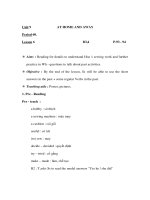Unit 04_Music and Arts Lesson 6 Skills 2_GV: Lưu Thùy Linh
Bạn đang xem bản rút gọn của tài liệu. Xem và tải ngay bản đầy đủ của tài liệu tại đây (746.59 KB, 18 trang )
<span class='text_page_counter'>(1)</span><div class='page_container' data-page=1>
<b>GOOD MORNING EVERYBODY</b>
<b>WELCOME TO CLASS </b>
</div>
<span class='text_page_counter'>(2)</span><div class='page_container' data-page=2>
<b> GUESSING GAME </b>
<b>WHO IS HE?</b>
<b>He’s a painter.</b>
<b>He is from Spain.</b>
</div>
<span class='text_page_counter'>(3)</span><div class='page_container' data-page=3>
<b>UNIT 4: MUSIC AND ARTS</b>
<b>PERIOD: 32</b>
<b>LESSON 6: SKILLS 2</b>
</div>
<span class='text_page_counter'>(4)</span><div class='page_container' data-page=4>
<b> THIS IS THE FIRST PICTURE </b>
<b>OF PICASSO</b>
</div>
<span class='text_page_counter'>(5)</span><div class='page_container' data-page=5>
- Sculpture (n) = tác phẩm điêu khắc
- training/ education( n) = Đào tạo
- produce (v) <sub>= sản xuất, chế tạo</sub>
- enormous (adj. ) <sub>= a lot of</sub>
</div>
<span class='text_page_counter'>(6)</span><div class='page_container' data-page=6>
<b>II. LISTENING</b>
<i><b>1. Listen to the passage about Picasso and </b></i>
<i><b>circle the words you hear.(Ex. 1/p.45)</b></i>
<b>1. artists</b>
<b>1. artists</b>
<b><sub>2. training</sub></b>
<b>2. training</b>
<b><sub>3. picture</sub></b>
<b>3. picture</b>
<b>4. portrait</b>
</div>
<span class='text_page_counter'>(7)</span><div class='page_container' data-page=7>
<b>1. When was Picasso born?</b>
<b>A. In 1881</b>
<b>A. In 1881</b>
<b>B. In 1896</b>
<b>B. In 1896</b>
<b>C. In 1973</b>
<b>C. In 1973</b>
<b>T</b>
<b>T</b>
<b>F</b>
<b>F</b>
<b>F</b>
<b>F</b>
</div>
<span class='text_page_counter'>(8)</span><div class='page_container' data-page=8>
<b>2. Picasso received artist training </b>
<b>from his father at ______</b>
<b>A. thirteen</b>
<b>A. thirteen</b>
<b>B. seven</b>
<b>B. seven</b>
<b>C. thirty</b>
<b>C. thirty</b>
<b>F</b>
<b>F</b>
<b>T</b>
<b>T</b>
<b>F</b>
<b>F</b>
</div>
<span class='text_page_counter'>(9)</span><div class='page_container' data-page=9>
<b>3. How many works of art did </b>
<b>Picasso produce?</b>
<b>A. 50,000</b>
<b>A. 50,000</b>
<b>B. 1,885</b>
<b>B. 1,885</b>
<b>C. 1,973</b>
<b>C. 1,973</b>
<b>T</b>
<b>T</b>
<b>F</b>
<b>F</b>
<b>F</b>
<b>F</b>
</div>
<span class='text_page_counter'>(10)</span><div class='page_container' data-page=10>
<b>4. Where did Picasso died? </b>
<b>A. In Malaga</b>
<b>A. In Malaga</b>
<b>B. In Barcelona</b>
<b>B. In Barcelona</b>
<b>C. In Mougins</b>
<b>C. In Mougins</b>
<b>F</b>
<b>F</b>
<b>F</b>
<b>F</b>
<b>T</b>
<b>T</b>
</div>
<span class='text_page_counter'>(11)</span><div class='page_container' data-page=11>
<b>II. LISTENING</b>
<i><b>3. Listen to the passage one more time. As a class, </b></i>
<i><b>discuss how the listening is organized </b></i>
<i><b>( according to a timeline, the order of important events, </b></i>
<i><b>or another way)(Ex. 3/p.45)</b></i>
<b>Timeline</b>
<b>1. 1881</b>
<b>2. 1888</b>
<b>3. 1894</b>
<b>4. 1896</b>
<b>5. 1973</b>
EVENTS
<b>was born in Malaga , Spain.</b>
<b>received formal artistic training from his father.</b>
<b>was admitted to a School of Fine Art in Barcelona.</b>
<b>completed “ Portrait of Aunt Pepa “.</b>
</div>
<span class='text_page_counter'>(12)</span><div class='page_container' data-page=12>
82 Tran Quoc Hoan Rd. Ha Noi
Nov 12, 20…
Dear David,
I’m happy to hear you are in Ha Noi again. This time, how
about watching a water puppet show? I’m sure you’ll like it. Is
Saturday evening OK for you? It’s at 57B Dinh Tien Hoang St.,
Hoan Kiem Dist. The show begins at 8 p.m, so let‛s meet at
7.45 outside the theatre. I hope we’ll have a happy time
together.
Looking forward to seeing you there.
Have a nice day!
Cheers,
Duong
<b>III. WRITING</b>
</div>
<span class='text_page_counter'>(13)</span><div class='page_container' data-page=13>
<i><b>Informal letter of invitation.</b></i>
<i><b> Writing tip</b></i>
<sub>Would you like + to……?</sub>
<sub>How about + V-ing ………?</sub>
<sub>What about + V-ing... ?</sub>
<i><sub>Time: Time to meet : </sub></i>
<i><sub>Place : Place to meet</sub></i>
</div>
<span class='text_page_counter'>(14)</span><div class='page_container' data-page=14>
<b>1. This letter is from Duong to _____.</b>
<b>A. a friend</b>
<i><b>1. Read the following letter and choose the </b></i>
<i><b>correct answer.(Ex. 4/p.45)</b></i>
</div>
<span class='text_page_counter'>(15)</span><div class='page_container' data-page=15>
<b>2. Duong write this letter </b>
<b>to____</b>
<b>A. Give an order</b>
<i><b>1. Read the following letter and choose the </b></i>
<i><b>correct answer.(Ex. 4/p.45)</b></i>
</div>
<span class='text_page_counter'>(16)</span><div class='page_container' data-page=16></div>
<span class='text_page_counter'>(17)</span><div class='page_container' data-page=17>
<b><sub> Learn new words by heart.</sub></b>
<b><sub>Do exercise 5 /P.45 in </sub></b>
<b>textbook.</b>
<b><sub>Prepare LOOKING BACK </sub></b>
<b>AND PROJECT.</b>
</div>
<span class='text_page_counter'>(18)</span><div class='page_container' data-page=18></div>
<!--links-->









